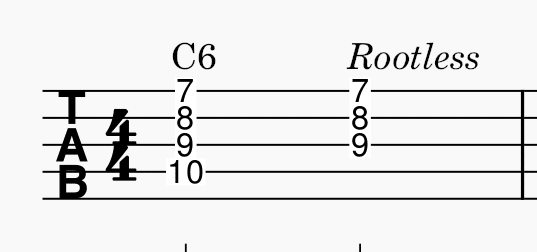Adding Color To Major Chords With The 6th
One of my favorite extensions or colors to add to major chords is the 6th. This is a chord that isn’t really dissonant, so it even works in folk or bluegrass tunes. Earl Scruggs uses it in “Blueridge Cabin Home” as a thumb chord in the backup.
What Is A 6th Chord
A G major scale consists of the notes:
G A B C D E F#
To construct a major chord, take the 1st, 3rd, and 5th note of the scale. In this case, G-B-D. If you wanted to represent this numerically it would be the scale degrees
1-3-5
Next, let’s add an additional note to this major chord. We want to add the SIXTH note of the scale, so the entire chord is spelled out:
1-3-5-6
This chord will contain the notes G-B-D-E. Here are a few fingerings for the banjo.

The first fingering with the pinky on the 10th fret contains all of the notes (1-3-5-6). However, the second fingering removes the 10th fret on the fourth string. This is called a rootless voicing. This is the one I use most of the time. Why? Because you can assume the guitarist or bass player will catch the root. Also, a lot of time, the context of the song kind of implies the bass is there when it isn’t. If I’m doing a solo banjo piece, I MAY be more apt to use the first voicing as no other instrument is there to play the bass.
C6 using the 5th string
Here is a cool way to grab a C6 chord using the 5th string. It will be a stretch with your THUMB to catch the 5th string, 7th fret. The good news is we usually don’t keep our thumb there long.

Where Do I Use This?
I predominantly use this in the backup but lots of songs have the 6th in the MELODY. A song like “East TN Blues” is a good example of a song where you can hold this chord and catch the melody.
For now, any time you have a major chord, try to use it in the backup. So, If your chord progression is G-C-D-G, try it over each of the chords. Unlike the 7th, it is fairly neutral and doesn’t necessarily push your ear into a certain chord, so you can use it more (Over the I, IV, or V chords). At the same time, I would never use it over every single chord in a song. You have to be tasteful about it otherwise it quickly loses it flavor. Usually a good bet is the IV or I chord. Understand, that the nature of the song will dictate whether you can use it. There are some songs where adding this will make the song sound to jazzy. It works great over rags, swingy type songs almost always.
Check out my article on the MINOR 6th for even more elaborate chord extensions.
Please consider signing up for my BANJO JOURNEY EMAIL NEWSLETTER. I’ll notify you when new articles, videos, or TABS have been uploaded. I send this out 2-3 times a month, no spamming!
As always, if you need one-on-one lessons, please contact me and I can help you. I teach anywhere in the world via ZOOM.
